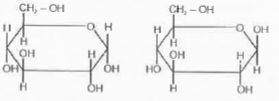The two cyclic hemiacetal forms of glucose differing only in the configuration of the hydroxyl group at C-1 are called
If both assertion and reason are true and reason is the correct explanation of assertion.
If both assertion and reason are true but reason is not the correct explanation of assertion.
If assertion is true but reason is false.
If both assertion and reason are false.
The correct Answer is:A
To solve the question regarding the two cyclic hemiacetal forms of glucose that differ only in the configuration of the hydroxyl group at C-1, we can follow these steps:
Step by Step Solution:
1. Understanding the Structure of Glucose:
Glucose is a six-carbon sugar (hexose) that can exist in a cyclic form. The cyclic form is created when the carbonyl group (C=O) reacts with a hydroxyl group (–OH) to form a hemiacetal.
2. Identifying the Cyclic Forms:
The cyclic forms of glucose can be represented as a pyranose (six-membered ring). In these forms, the carbon atom that was part of the carbonyl group (C-1) becomes a new chiral center.
3. Differentiating the Anomers:
The two cyclic forms of glucose that differ only at the configuration of the hydroxyl group at C-1 are:
- Alpha (α) D-Glucose: In this form, the hydroxyl group (-OH) at C-1 is positioned on the opposite side (trans) of the CH2OH group at C-5.
- Beta (β) D-Glucose: In this form, the hydroxyl group (-OH) at C-1 is positioned on the same side (cis) as the CH2OH group at C-5.
4. Defining Anomers:
The terms used to describe these two forms are known as anomers. Anomers are a specific type of epimer that differ in configuration at the anomeric carbon (C-1 in this case).
5. Conclusion:
Therefore, the two cyclic hemiacetal forms of glucose differing only in the configuration of the hydroxyl group at C-1 are called anomers.
Final Answer:
The two cyclic hemiacetal forms of glucose differing only in the configuration of the hydroxyl group at C-1 are called anomers.
Glucose is a six-carbon sugar (hexose) that can exist in a cyclic form. The cyclic form is created when the carbonyl group (C=O) reacts with a hydroxyl group (–OH) to form a hemiacetal.
The cyclic forms of glucose can be represented as a pyranose (six-membered ring). In these forms, the carbon atom that was part of the carbonyl group (C-1) becomes a new chiral center.
The two cyclic forms of glucose that differ only at the configuration of the hydroxyl group at C-1 are:
- Alpha (α) D-Glucose: In this form, the hydroxyl group (-OH) at C-1 is positioned on the opposite side (trans) of the CH2OH group at C-5.
- Beta (β) D-Glucose: In this form, the hydroxyl group (-OH) at C-1 is positioned on the same side (cis) as the CH2OH group at C-5.
The terms used to describe these two forms are known as anomers. Anomers are a specific type of epimer that differ in configuration at the anomeric carbon (C-1 in this case).
Therefore, the two cyclic hemiacetal forms of glucose differing only in the configuration of the hydroxyl group at C-1 are called anomers.
The two cyclic hemiacetal forms of glucose differing only in the configuration of the hydroxyl group at C-1 are called anomers.
Topper's Solved these Questions
- BIOMOLECULESBook:NCERT FINGERTPS ENGLISHChapter:BIOMOLECULESExercise:Carbohydrates
Explore 35 Videos
- BIOMOLECULESBook:NCERT FINGERTPS ENGLISHChapter:BIOMOLECULESExercise:Proteins
Explore 30 Videos
- BIOMOLECULESBook:NCERT FINGERTPS ENGLISHChapter:BIOMOLECULESExercise:EXEMPLER PROBLEMS
Explore 16 Videos
- AMINES Book:NCERT FINGERTPS ENGLISHChapter:AMINES Exercise:ASSERTION & REASON CORNER
Explore 14 Videos
- CHEMICAL KINETICSBook:NCERT FINGERTPS ENGLISHChapter:CHEMICAL KINETICSExercise:Assertion And Reason
Explore 15 Videos
Similar Questions
Two cyclic hemiacetal forms of glucose given below are called as

View SolutionCorrect the following statements by changing the underlined part of the sentence (Do not change the whole sentence).
α- D - glucose and β - D - glucose which differ in the orientation of hydroxyl groups C-1 are called epimers–––––––––,
View Solution
Knowledge Check
Glucose and galactose differ in configuration at:
AC–1BC-2CC-3DC-4
A pair of diastereomers that differ only in the configuration about a single carbon atom are called
View Solutionα−and β−Glucose differ in the orientation of the (−OH) group around:
View SolutionStructures which differ in configuration around C - 1 atom are called............
View SolutionDifferent forms of a gene are called
View SolutionThe process of formation of glucose form lipids is called
View SolutionPropane forms only one alkyl group.
View SolutionThe two forms of D-glucopyranose obtained from solution of D-glucose are known as:
View Solution